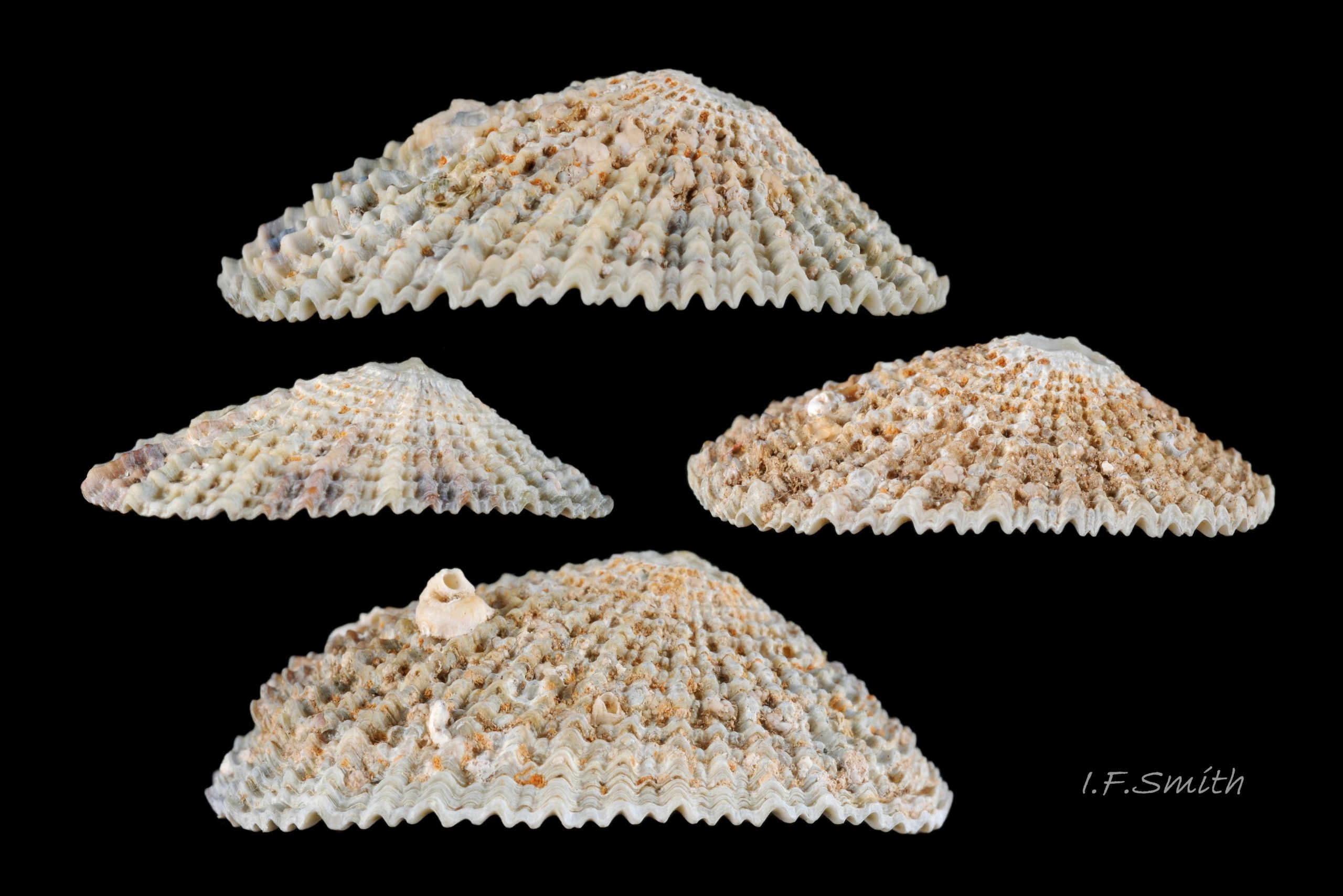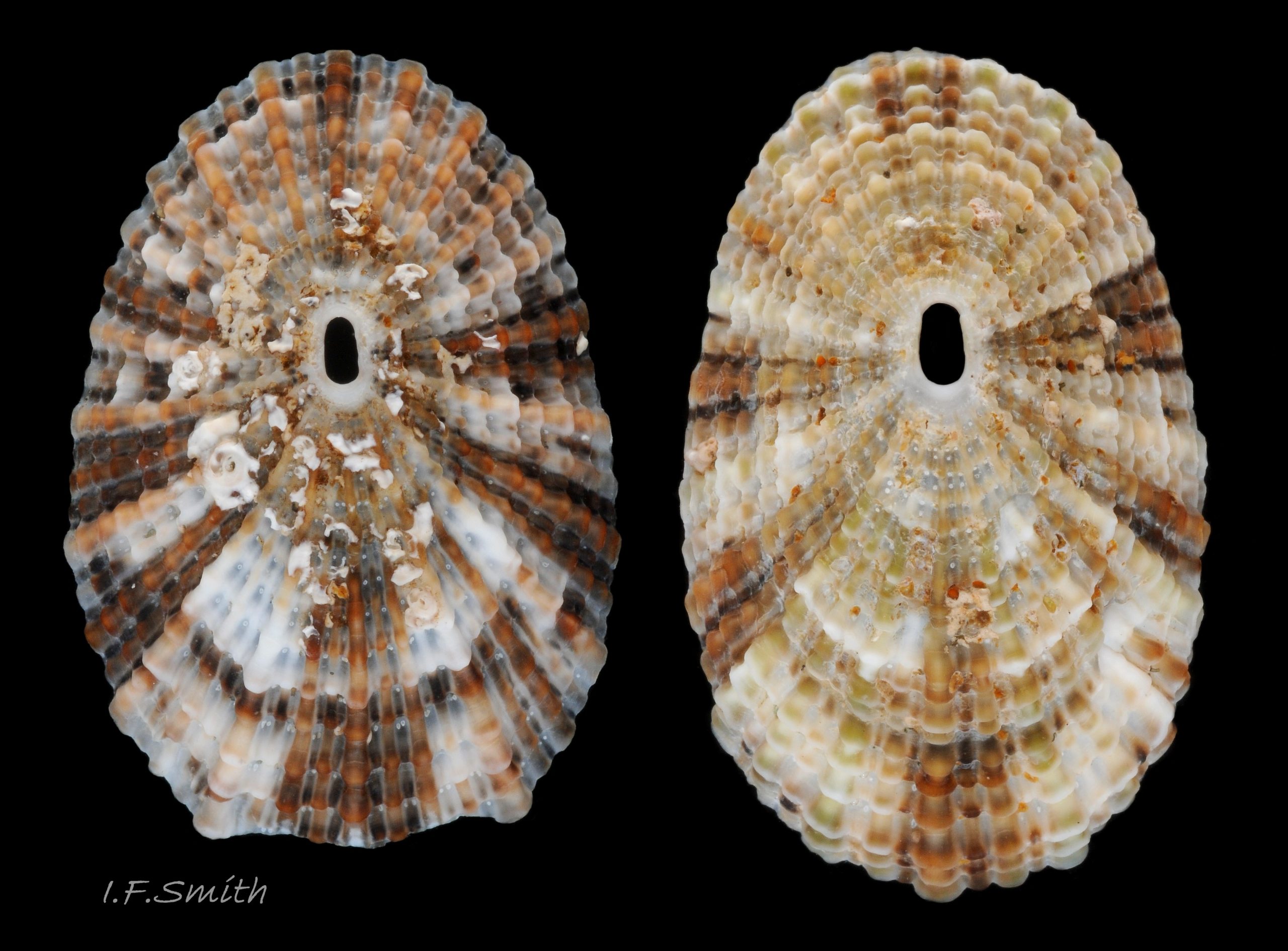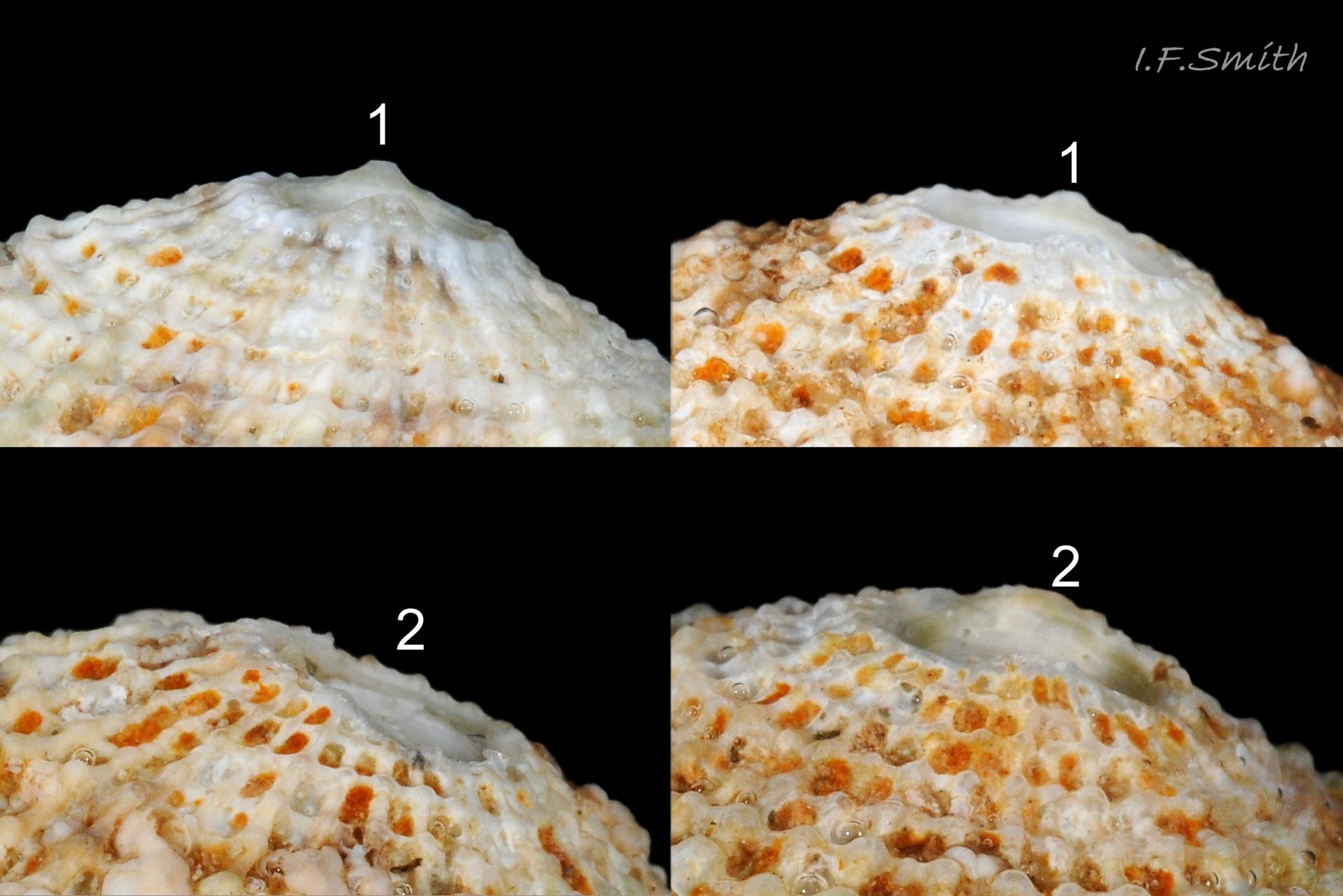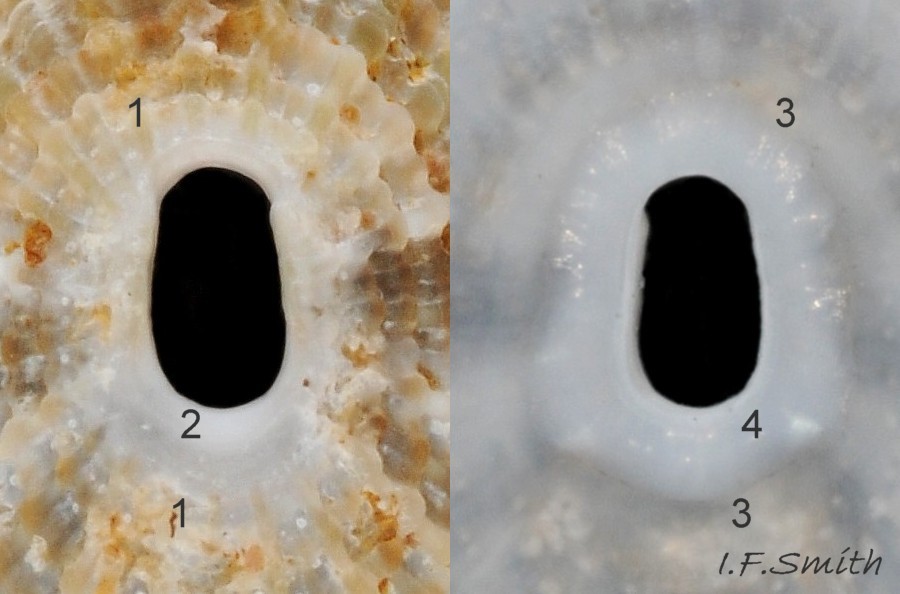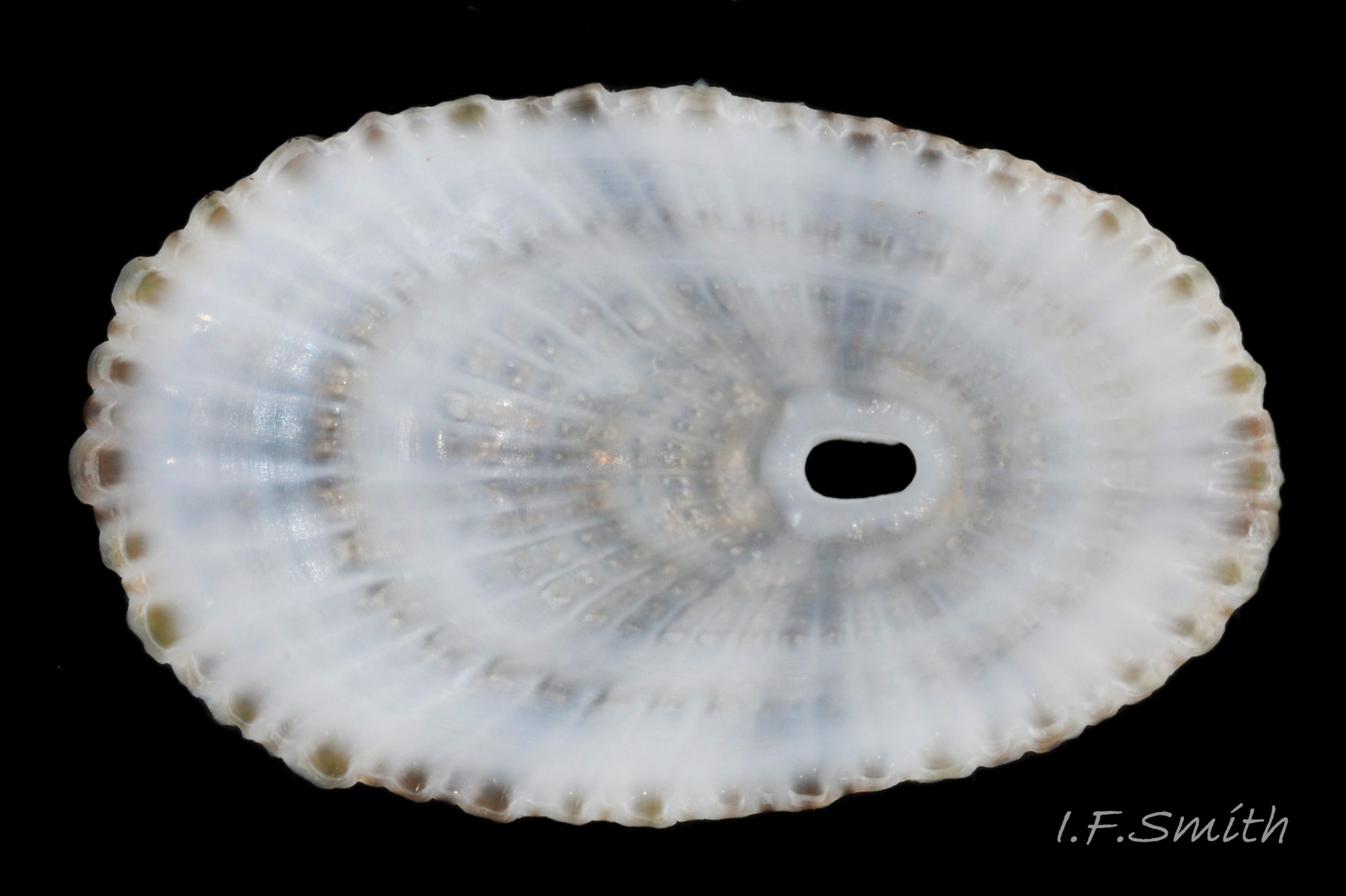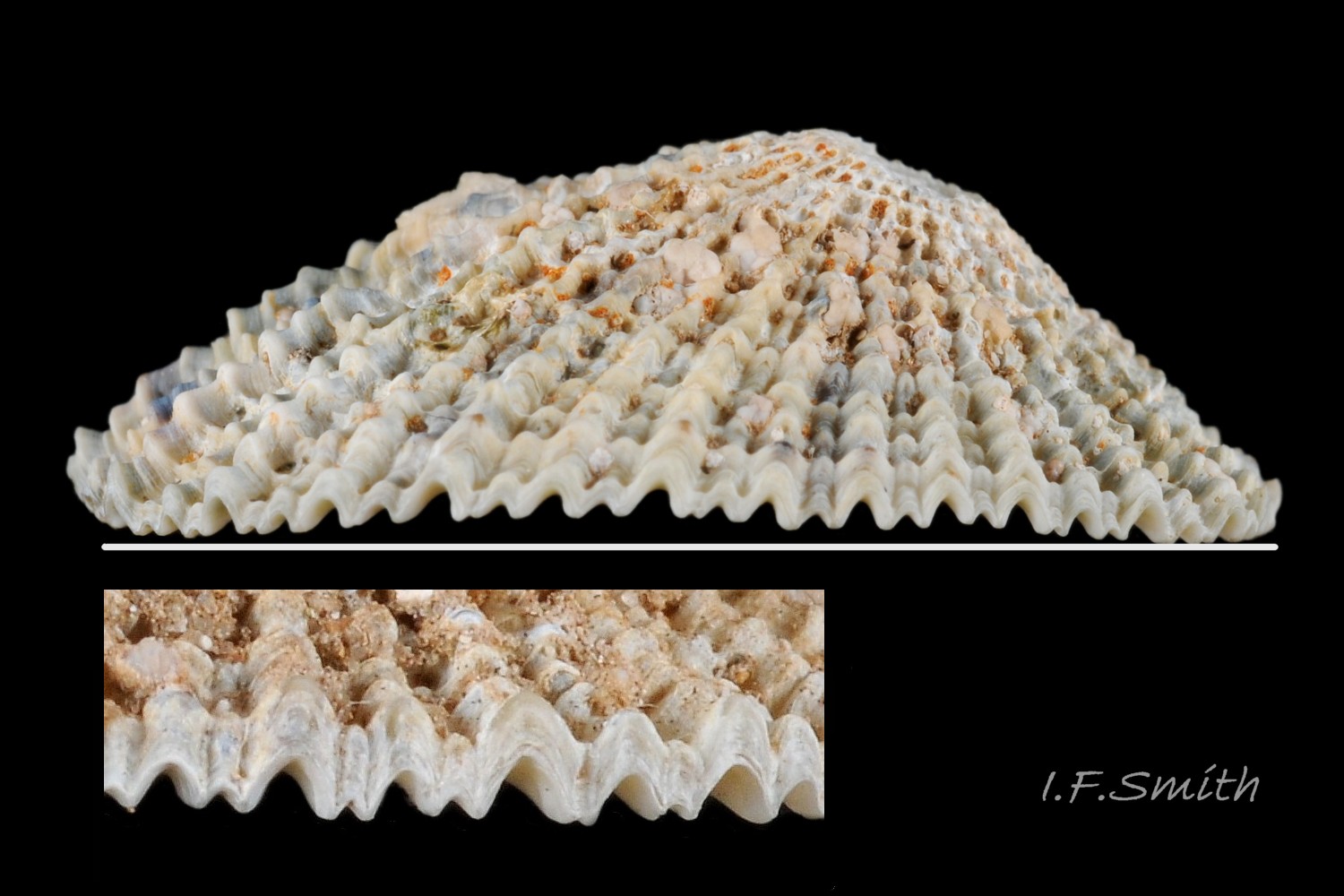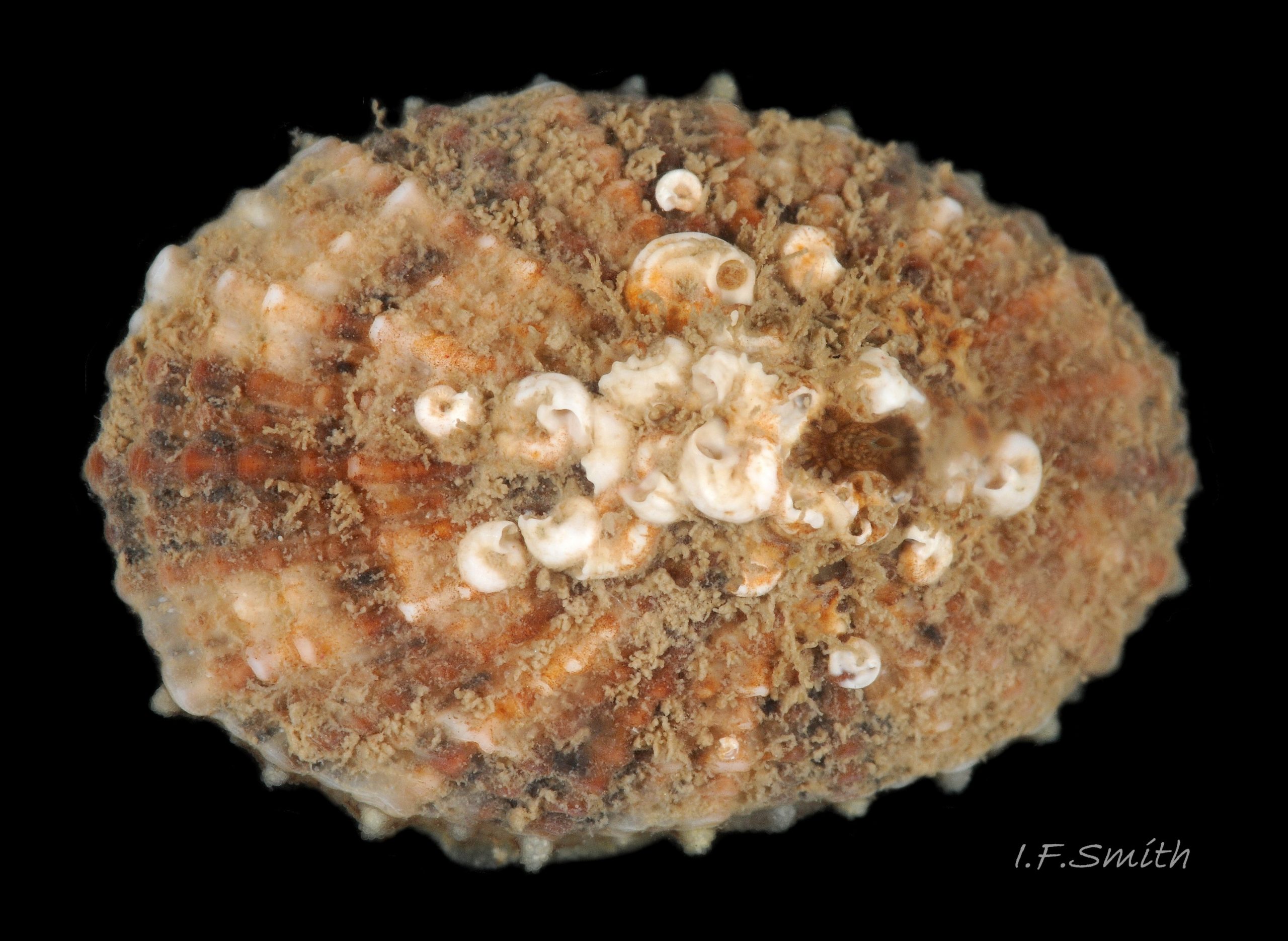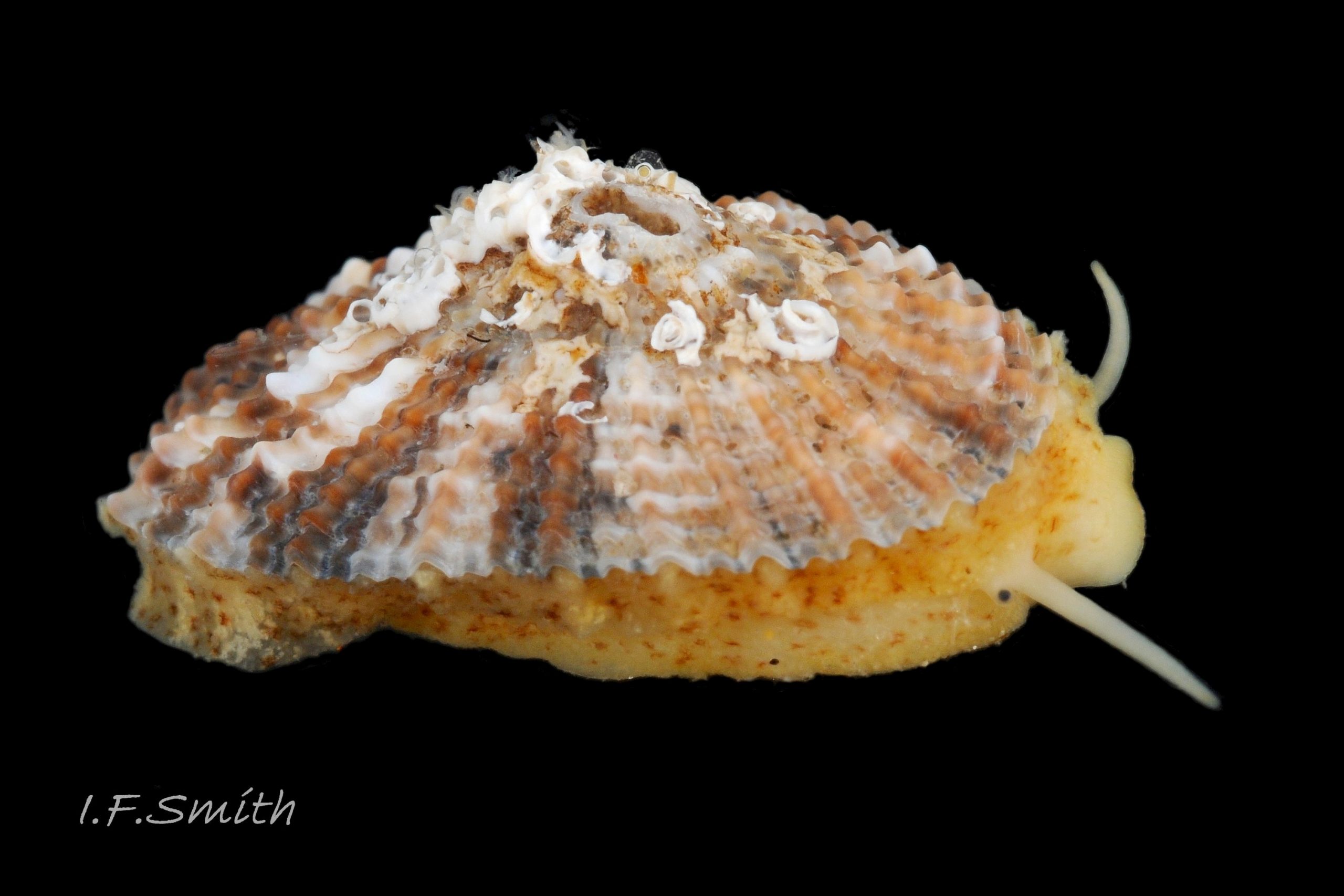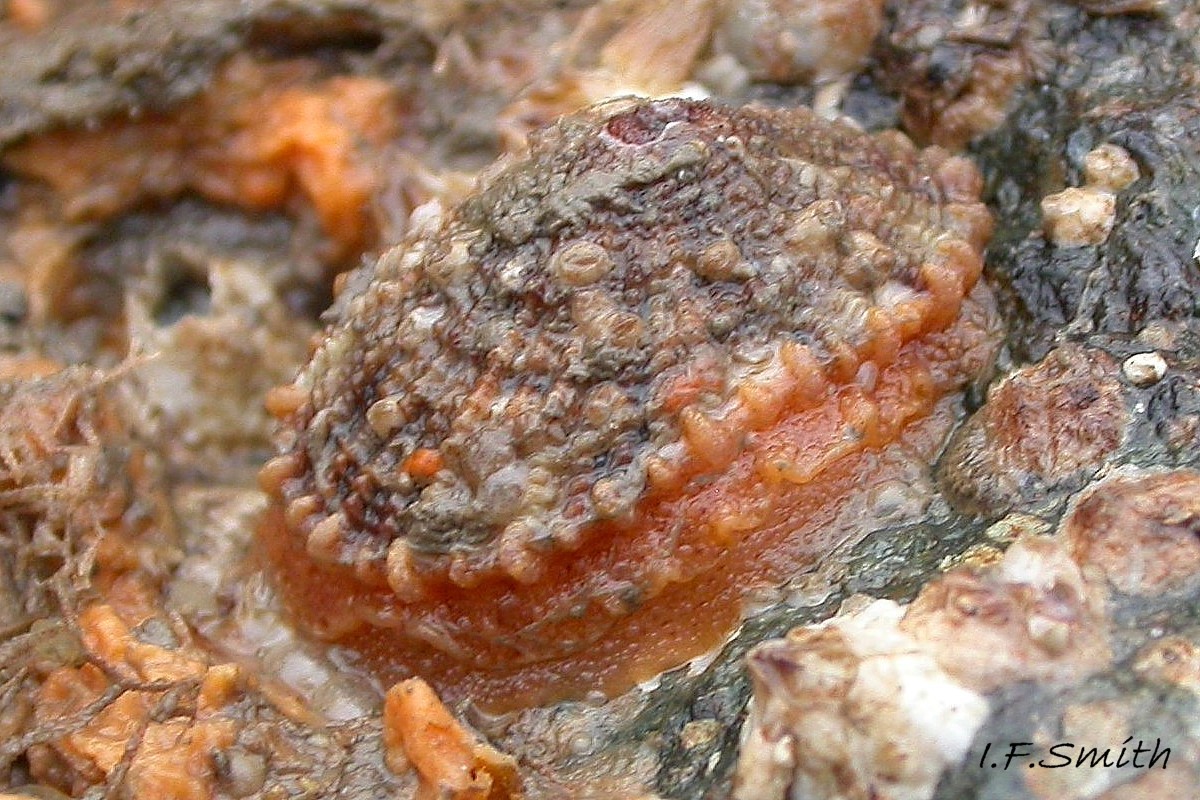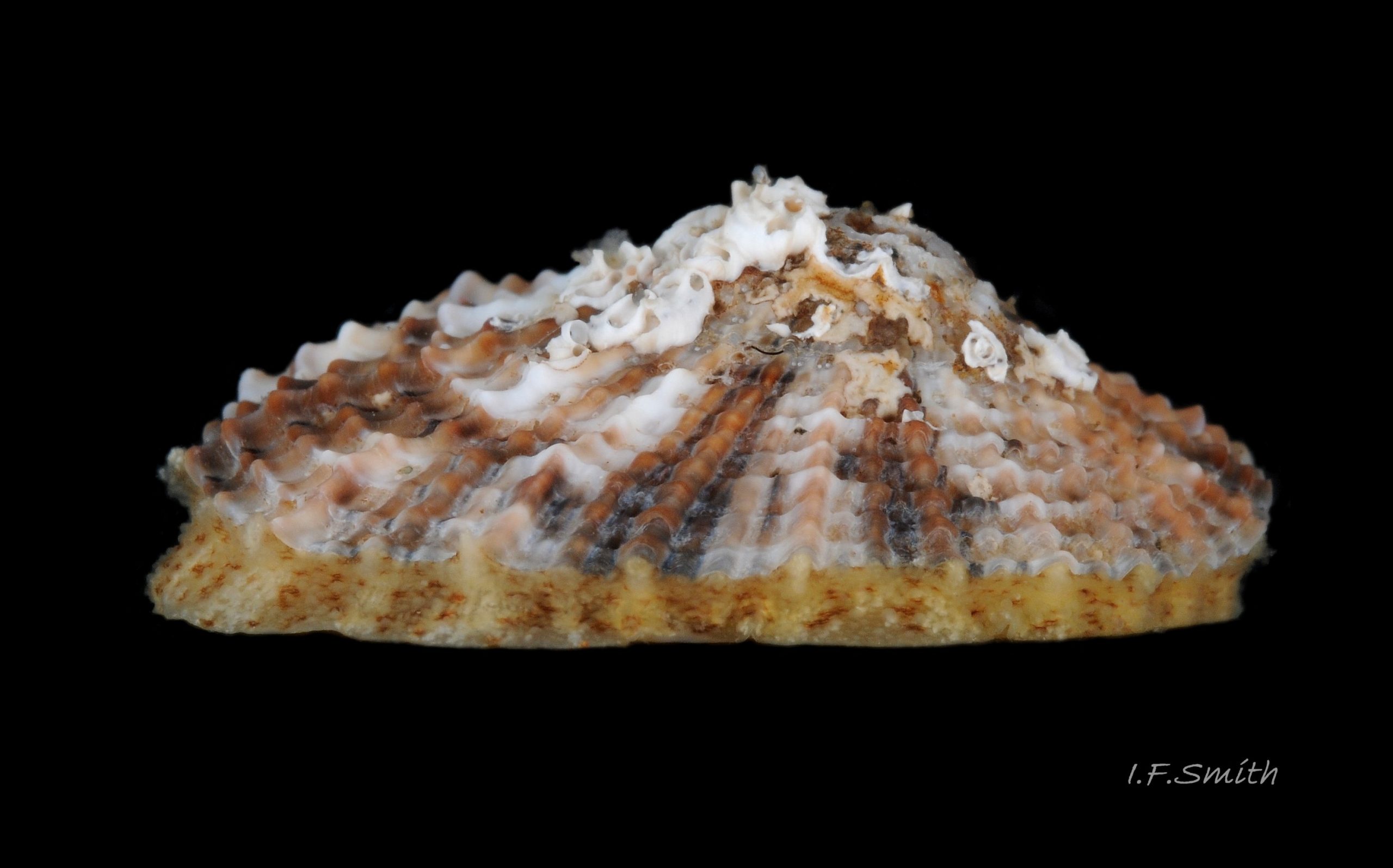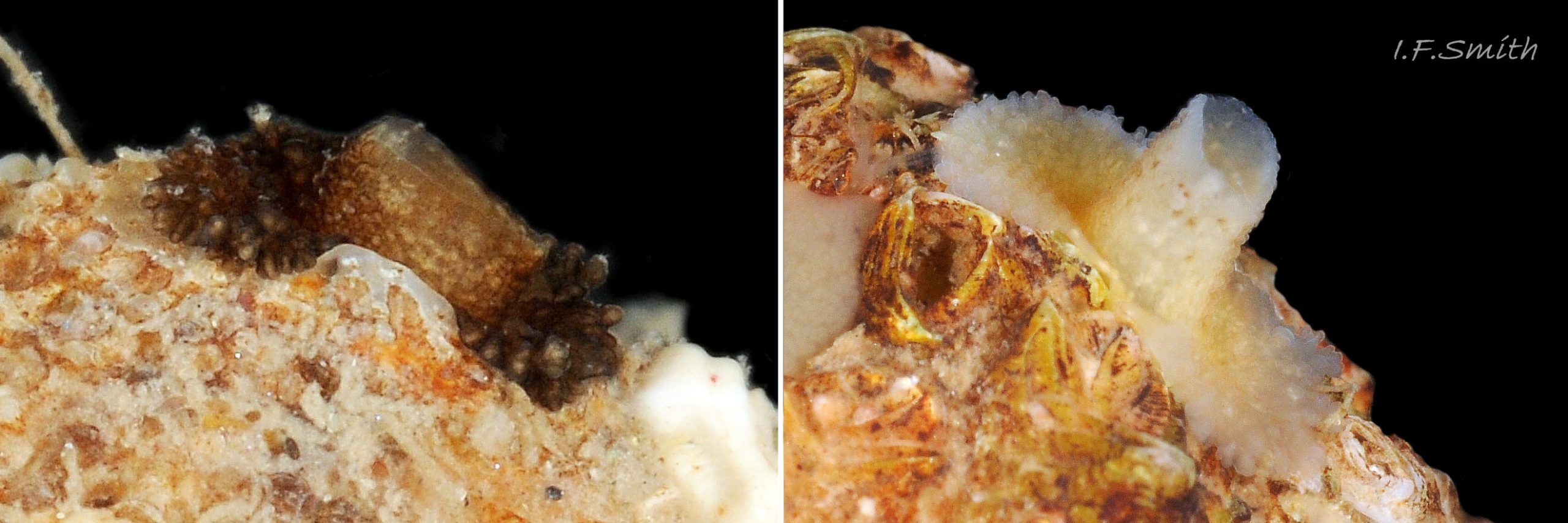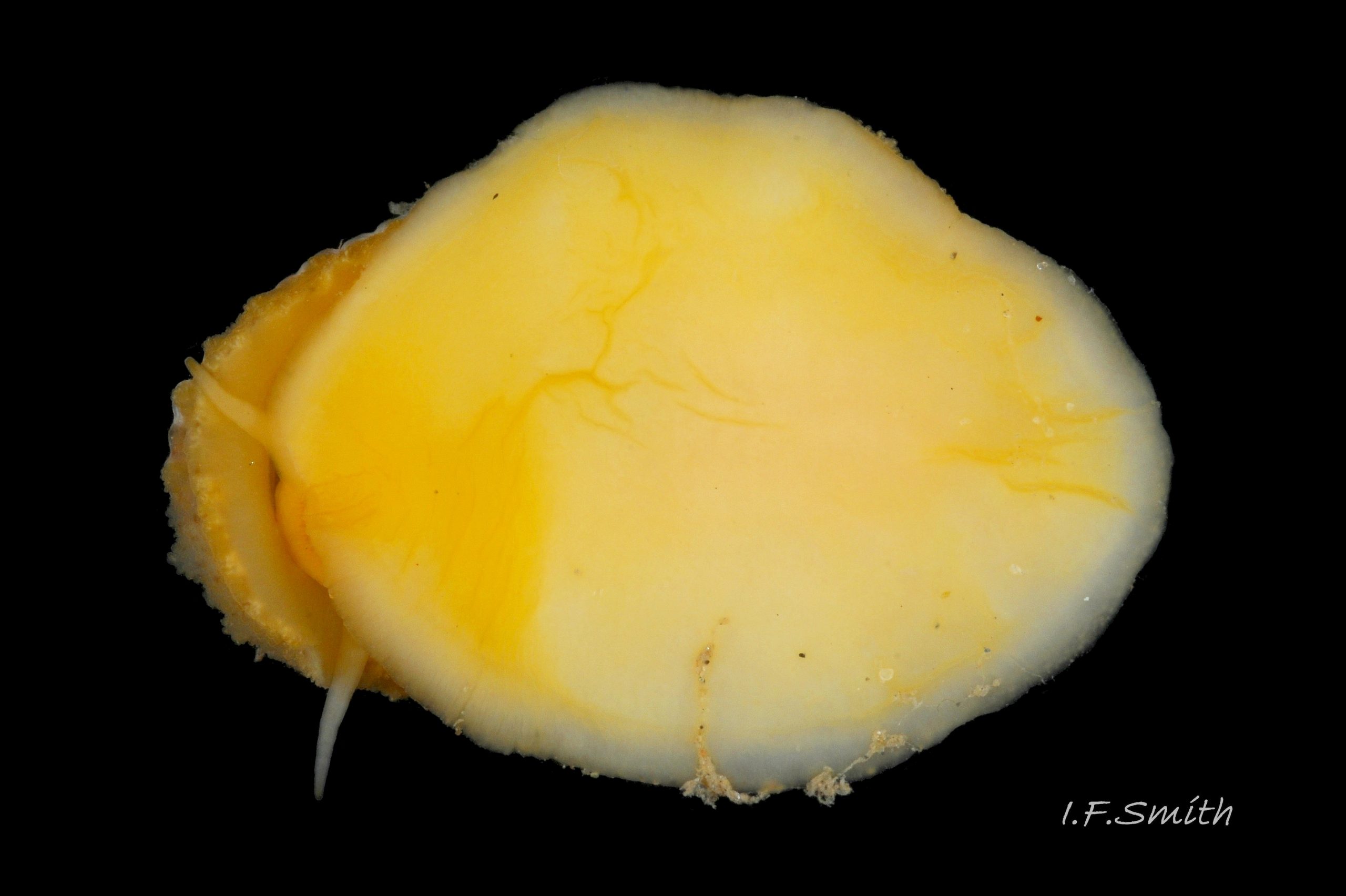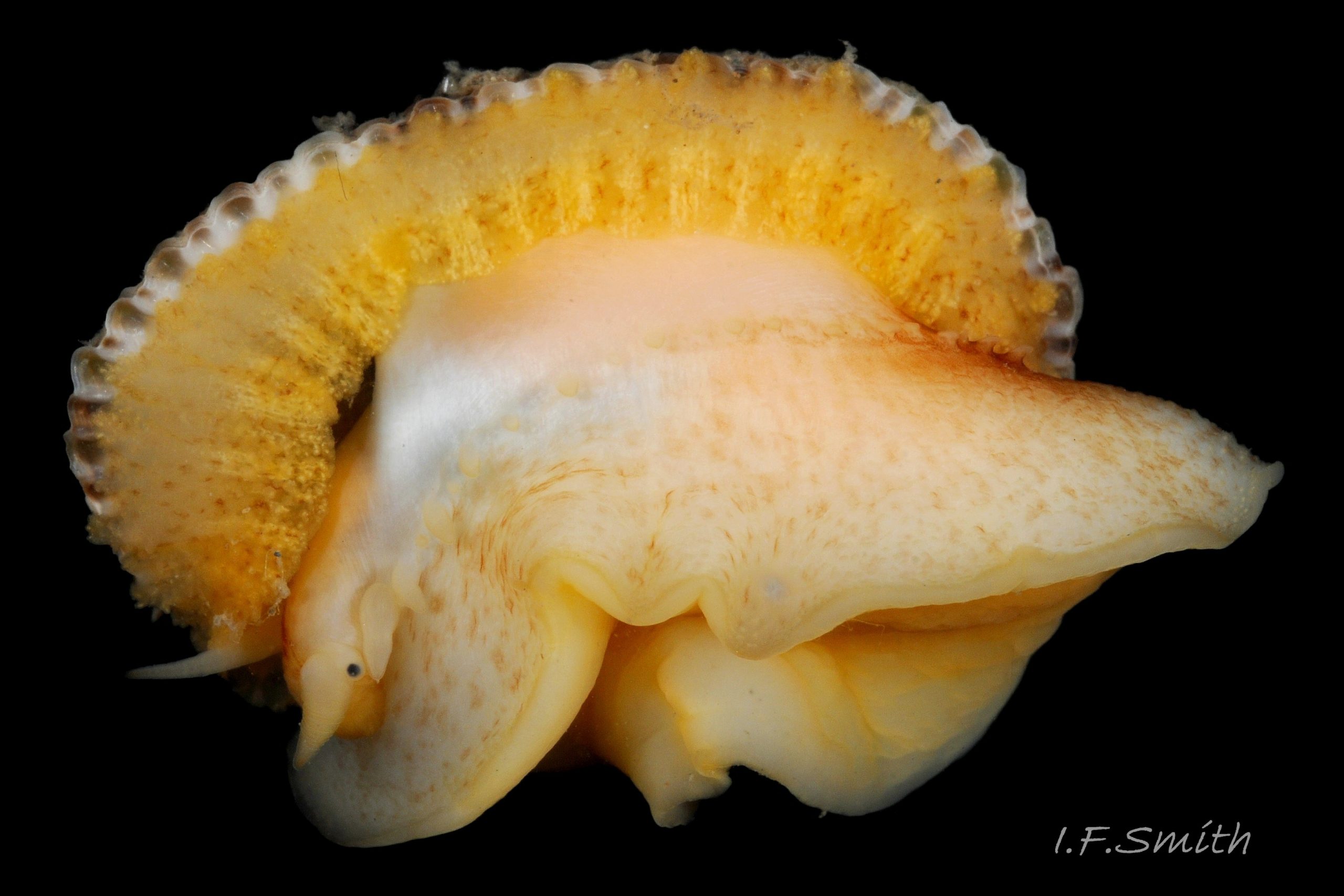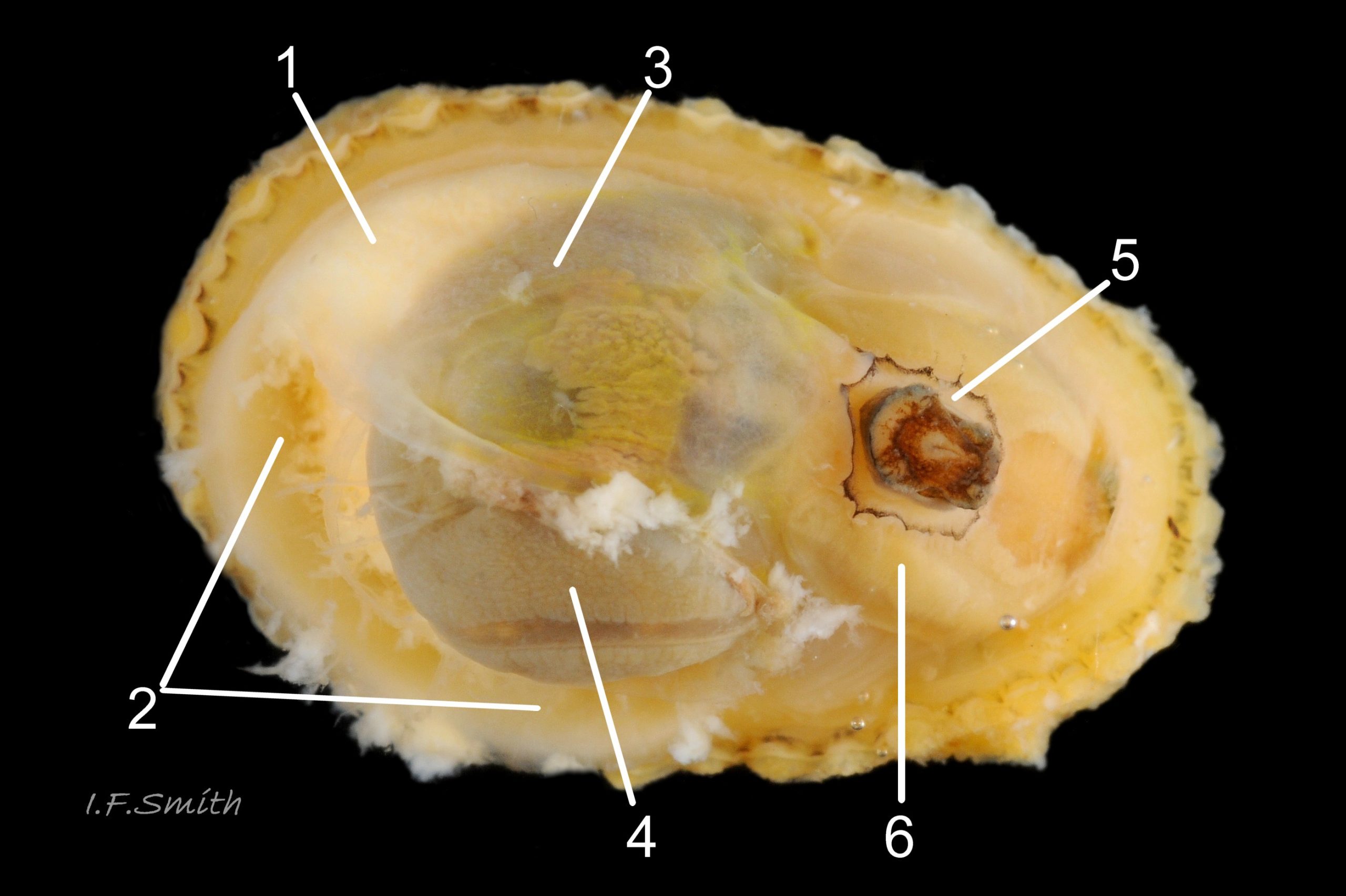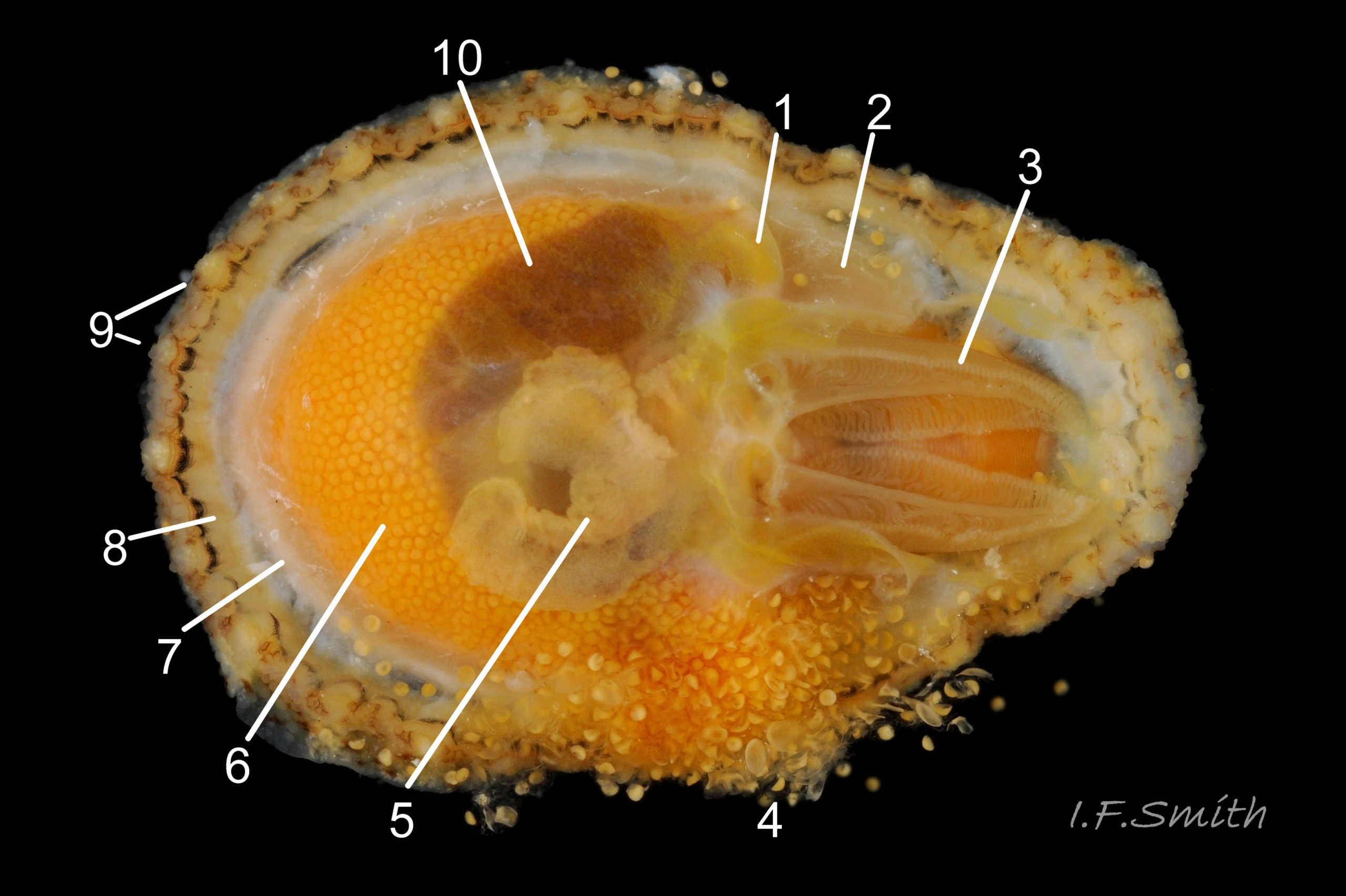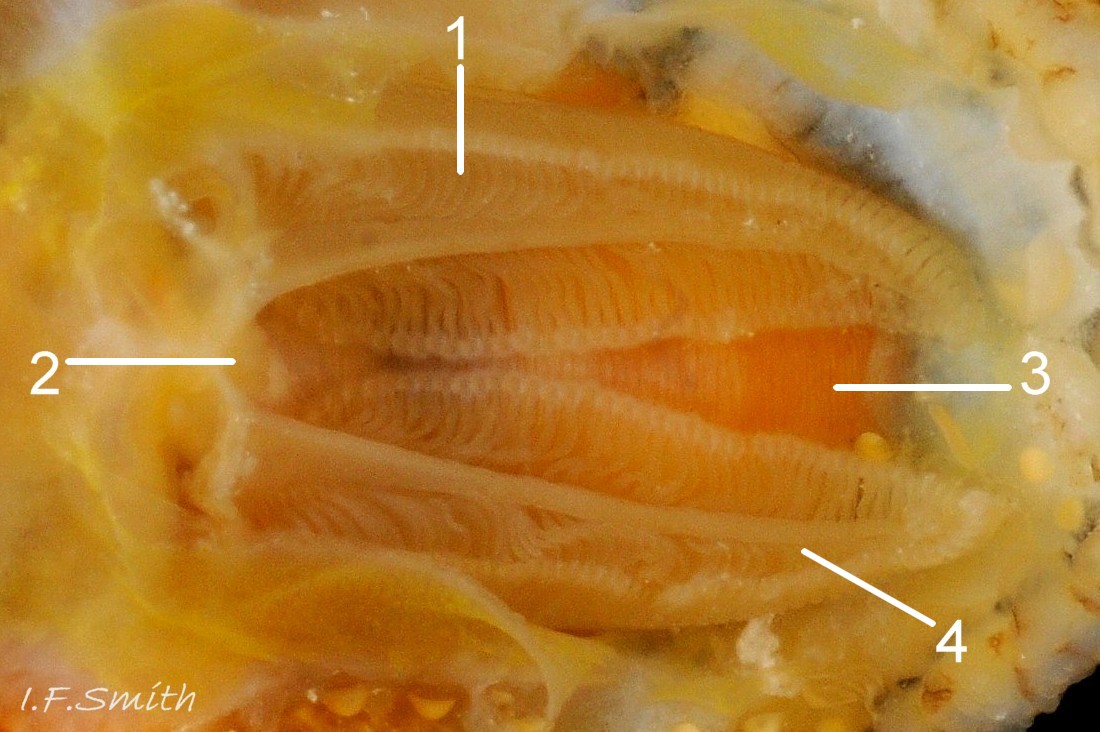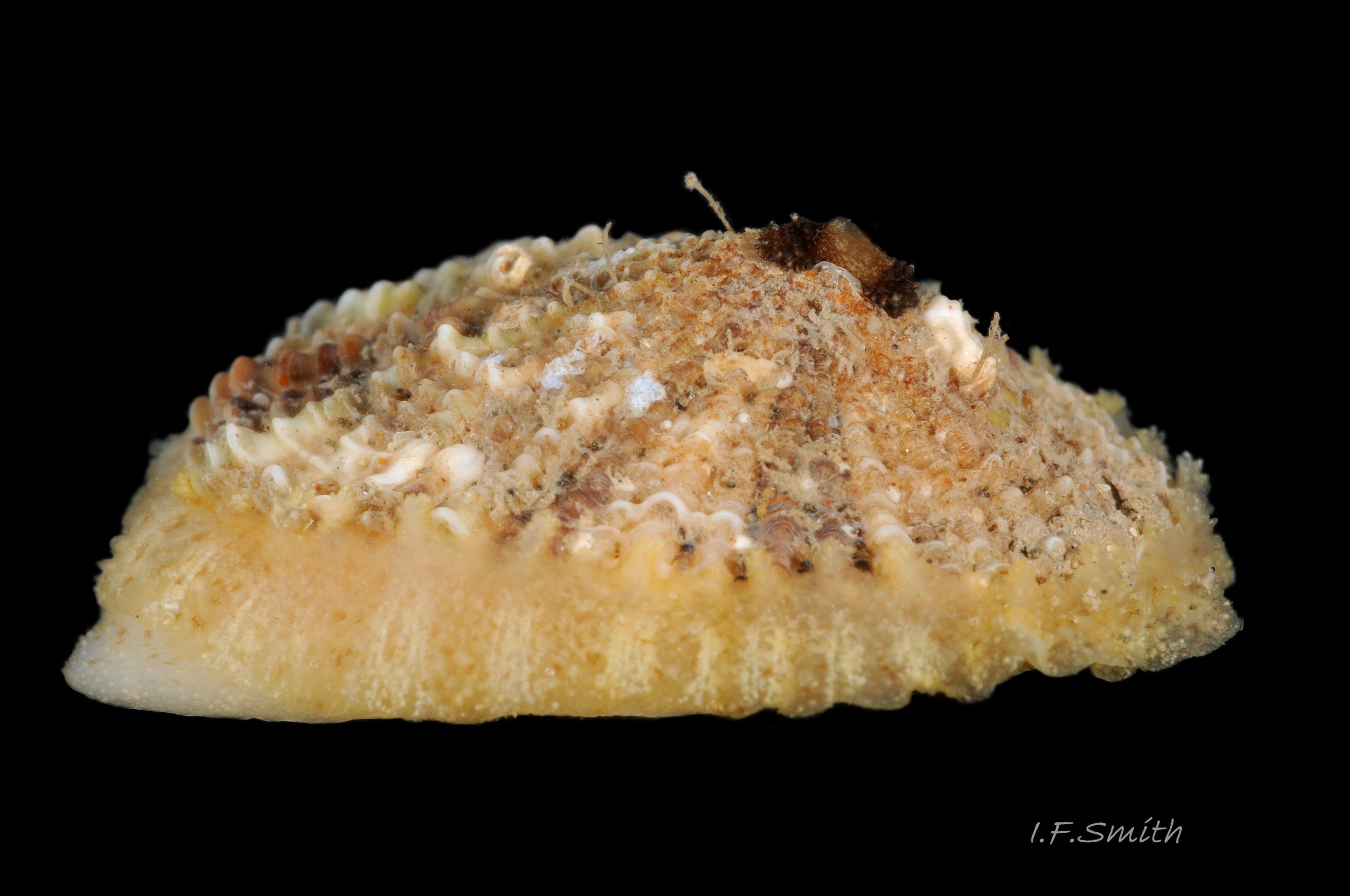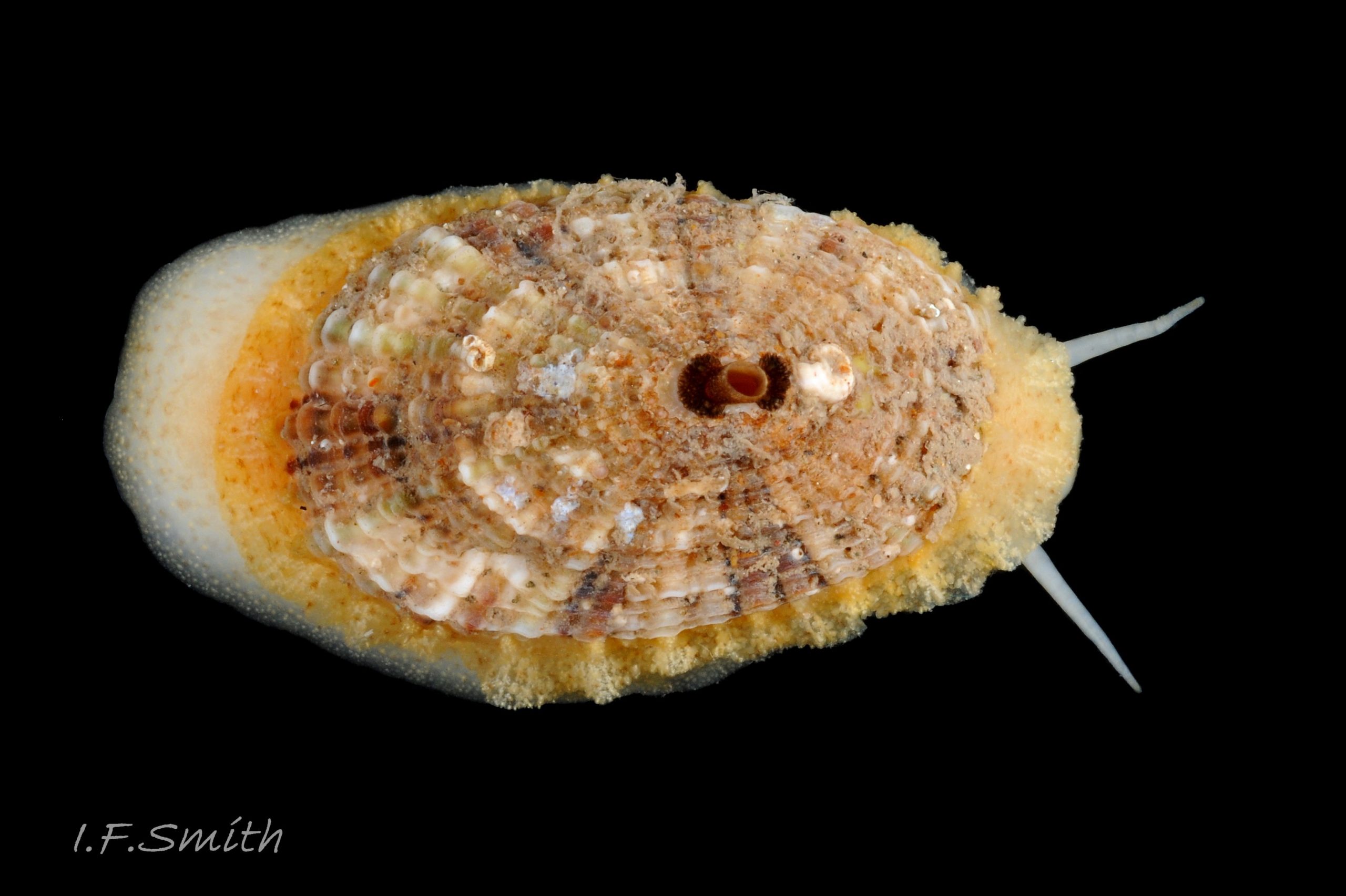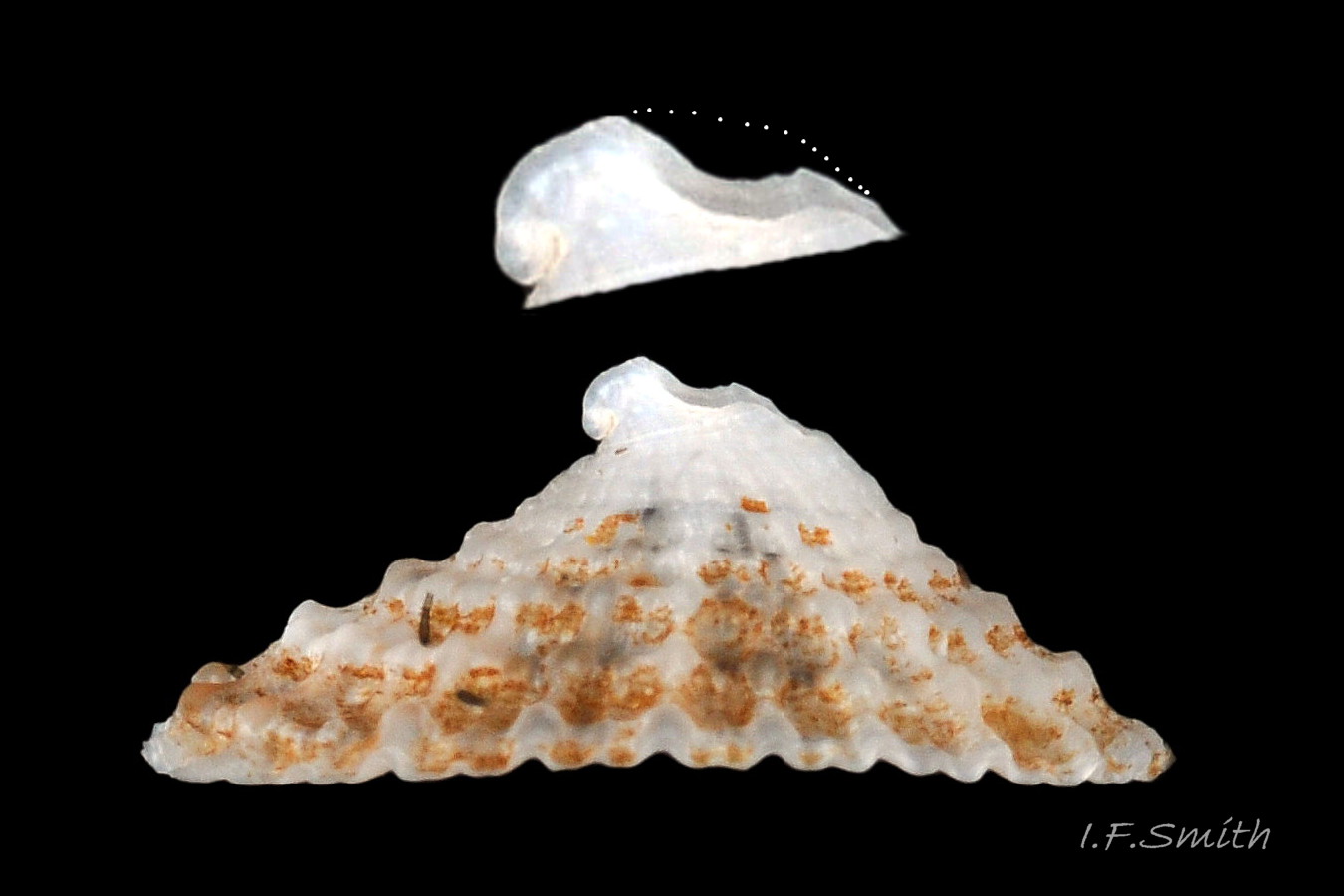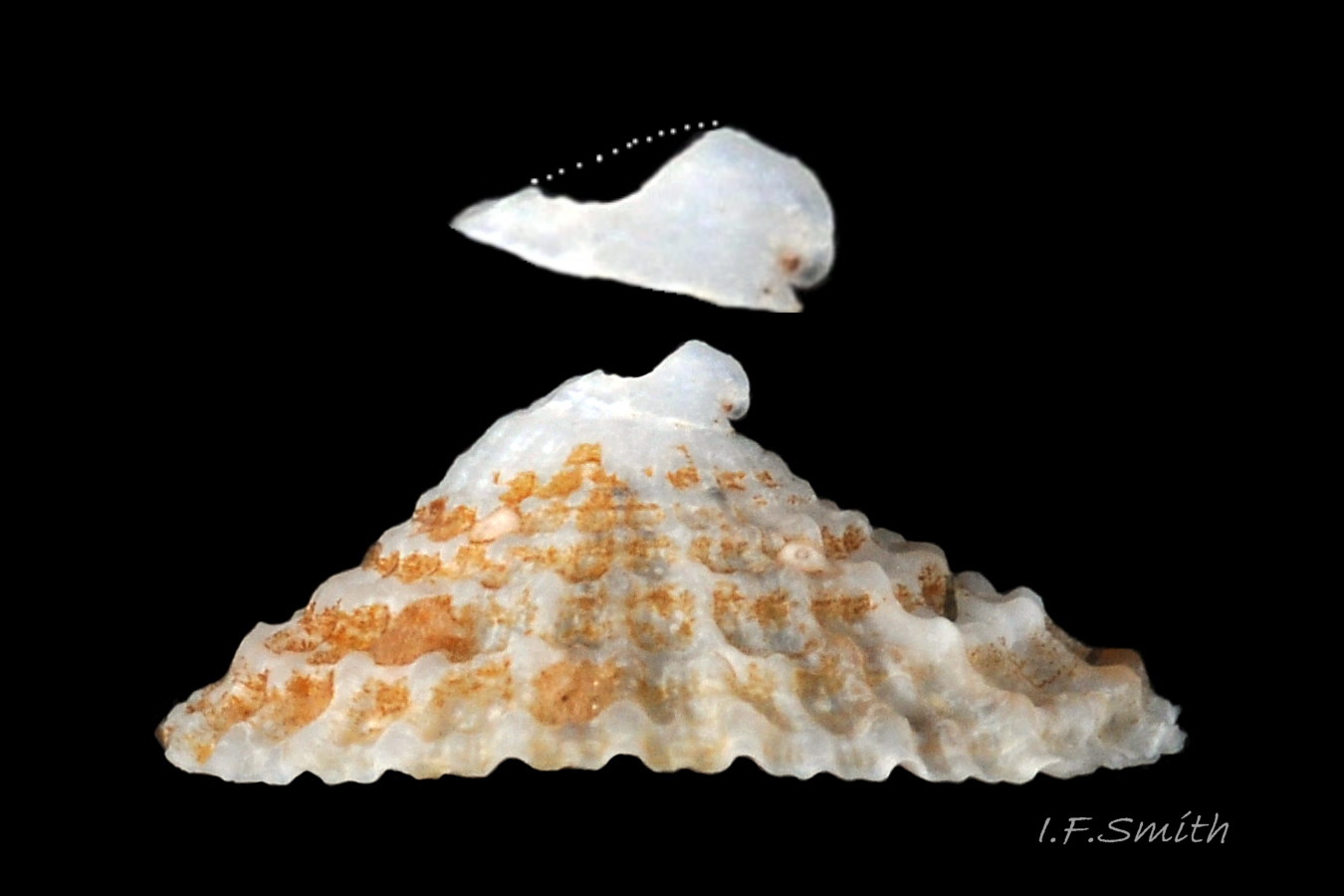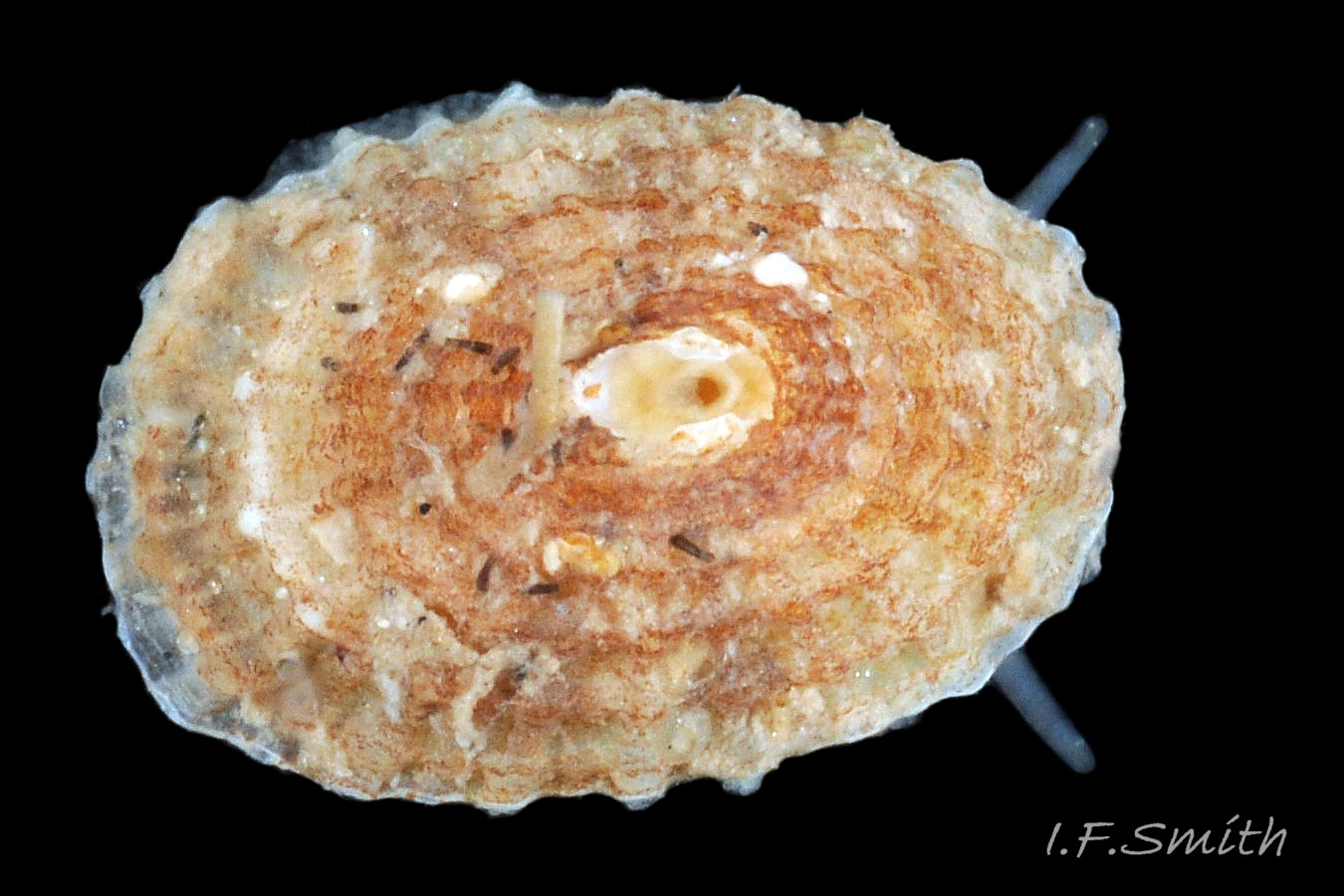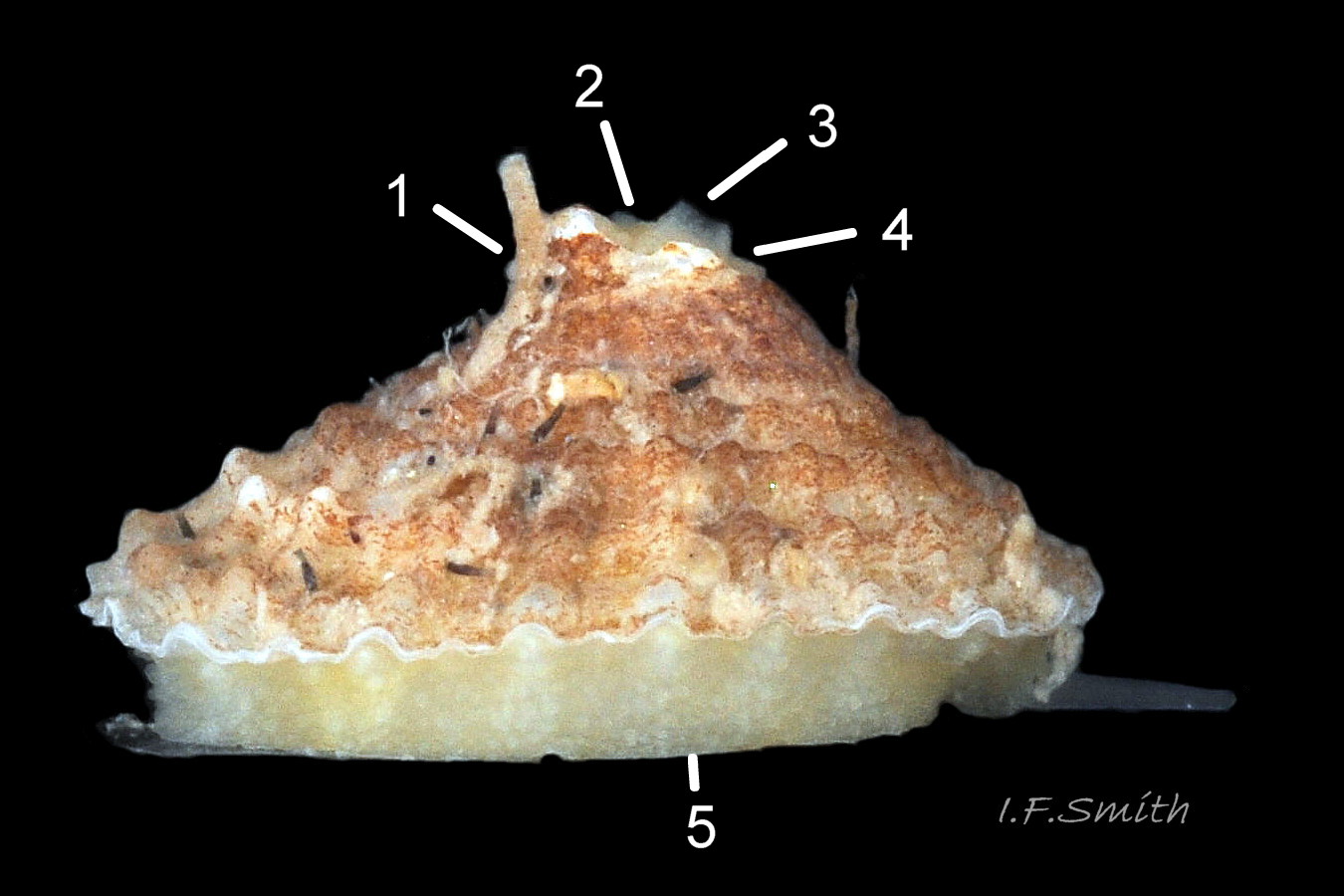Click image to enlarge with full caption. Main text below slider.
Diodora graeca (Linnaeus, 1758)
PDF available at www.researchgate.net/publication/270566202_Diodora_graeca…
Current taxonomy: World Register of Marine Species (WoRMS) www.marinespecies.org/aphia.php?p=taxdetails&id=139951
Synonyms:Patella graeca Linnaeus, 1758; Fissurella graeca (Linnaeus, 1758) [in Jeffreys]; Fissurella reticulata (da Costa, 1778); Diodora apertura (Montagu, 1803); [F. reticulata, Donovan in Forbes & Hanley].
Meaning of scientific name: Diodora = woman’s name, graeca = Greek.
Vernacular: Keyhole limpet (English); Brenigen bendoll (Welsh); sleutelgathoren (Dutch); fissurelle (French).
*GLOSSARY below.
Key identification features
·Diodora graeca
·Limpet with ‘keyhole’ aperture in front of forward tilted apex, one third of way from anterior edge of shell.
·Maximum size: height 10mm, length 25mm.
·Littoral and sublittoral on most rocky coasts of Britain & Ireland, but not North Sea or N.E. Irish Sea.
Shell Description
Height of cone up to 10mm. Those living intertidally usually smaller. Conical, usually straight or concave anterior profile; straight or convex posterior profile 01 Diodora graeca . Apex about a third of way from anterior, with slit aperture immediately in front. Slit varies in size on shells of same size 02 Diodora graeca ; rounded at anterior and posterior ends, slightly constricted at mid point giving a keyhole or figure-8 outline. Very small young have spiral protoconch 23 Diodora graeca & 24 Diodora graeca, but soon lost through erosion/ expansion of apical aperture. Rim often raised at mid point, but erosion may remove this and the constriction 03 Diodora graeca . Slit also constricted at interior end by an encircling shelf 04 Diodora graeca . Sculpture of upturned, concentric, annual growth rings; about thirteen on 17.5mm long specimen; number is underestimate of age as earliest rings destroyed by apical aperture enlarging with growth of shell. Up to fifty radiating flattish-topped ridges with narrow intervening grooves cut across growth rings, producing a pan-tile roof effect 02 Diodora graeca . Main aperture up to 25mm long, 15mm broad. Elongated ellipse, posterior wider than anterior 05 Diodora graeca . Ratio width:length varies 02 Diodora graeca . Edge crenulated by ends of ridges. Lateral edge of aperture arched up from horizontal; not moulded to substrate as usually rests on foot 06 Diodora graeca . Interior of shell coated with white porcellanous nacre, thickened into pronounced rim around apical aperture 04 Diodora graeca , and with short radial grooves at edge of main aperture aligned with ridges on dorsal surface. Larval operculum lost at metaphorphosis. Ground colour of shell exterior almost lustreless whitish and/or tan-white with, often incomplete, radiating bands of grey, rusty-, greenish- or dark-brown 02 Diodora graeca. Bands faintly visible on interior 05 Diodora graeca . Live shells often coated with detritus and epizooic growths 07 Diodora graeca. . Colours fade on dead shells 01 Diodora graeca . Periostracum imperceptible.
Body description
Flesh cream, pale yellow 26 Diodora graeca , yellow 08 Diodora graeca , orange 09 Diodora graeca or red, often spotted with a darker shade (except tentacles, part of snout, and body above epipodial tentacles 10 Diodora graeca . Snout large with thick lips 10 Diodora graeca , can project downwards or forwards 08 Diodora graeca . Cephalic tentacles long, colour as body, or paler, without darker spots. Small black eye on very small peduncle at base of each cephalic tentacle 8Dg 08 Diodora graeca . Elaborate mantle has three folds: 1. outer fold reaches aperture rim 19 Diodora graeca, in contact with inner surface of shell, produces calcareous matter to line interior and enable growth at edge of aperture, 2. middle fold extends as nodular glandular tentacles (possibly secrete repugnatory matter) protruding at ends of radiating shell ridges 09 Diodora graeca & 11 Diodora graeca, 3. greatly enlarged inner fold forms curtain, often completely shielding head and foot 12 Diodora graeca but they may protrude when in motion 08 Diodora graeca , and at times mantle is drawn within shell 13 Diodora graeca Mantle also extends from apical slit as brown exhalent siphon accompanied by rounded, dark brown, densely lobular, anterior and posterior lappets; on some adults these features are yellowish white with little pigment 14 Diodora graeca.; and juveniles usually lack much pigment 25 Diodora graeca & 26 Diodora graeca. Lobules may produce repugnatory substances, and, as the lappet bases are neatly recessed in the rounded ends of the “keyhole”, very probably substances to dissolve/resorb shell as the apical slit aperture is enlarged. Sides of slit are constricted and higher perhaps because not touched by lappets; lesser enlargement there may be caused by secretions from narrower erect siphon. Encircling nacreous shelf around base of apical slit may be because nacre (aragonite) is more resistant than calcite of outer shell or is deposited faster than resorbed, or because underside of lappets do not reach down so far. Foot, sole a broad ellipse 15 Diodora graeca, sometimes anterior indented centrally 16 Diodora graeca. Coloured as mantle or paler, except sole which lacks darker spots. When emersed from water, usually much of foot and mantle remain exposed 09 Diodora graeca. Defence may rely on repugnatorial glands in mantle skirt and sides of foot, though latter may be antiseptic rather than repugnatorial (Fretter & Graham 1994). Junction line of foot with upper body has row on each side of about 30 touch-sensitive epipodial tentacles, usually alternating large / small 13 Diodora graeca. Enlarged epipodial tentacle at base of right eye peduncle has been mistaken for penis, but D. graeca has none (enlarged epipodial tentacle on both sexes and also by left eye 17 Diodora graeca). Strong whitish horseshoe-shape shell-muscle connects animal to shell 17 Diodora graeca.
Internal anatomy visible with simple dissection
When the shell is removed, the whole mantle is exposed. The central part is translucent except for the brown apical siphon, dark-brown siphon-lappets and a broad dark-edged collar round the siphon. Several features can be seen through the mantle 18 Diodora graeca, but are more easily viewed if it is removed 19 Diodora graeca. The peripheral mantle skirt has dark scallop marks where it fitted the crenate shell-edge 19 Diodora graeca. In the nuchal cavity above the head, and below the apical siphon, are two ctenidia, symmetrically arranged with the central anus and kidney opening at their base 20 Diodora graeca. Behind the anus are the kidney, digestive gland and gonad (orange and granular with ova in female 19 Diodora graeca, whitish in male 18 Diodora graeca). Next to the left ctenidum is the style sac region of stomach. Encircling the viscera, and separating them from the mantle skirt, is the white horseshoe-shaped shell-muscle (severed to remove previously anaeshetised and killed animal from shell).
Key identification features
·Diodora graeca
·Limpet with ‘keyhole’ aperture in front of forward tilted apex, one third of way from anterior edge of shell.
·Maximum size: height 10mm, length 25mm.
·Littoral and sublittoral on most rocky coasts of Britain & Ireland, but not North Sea or N.E. Irish Sea.
Similar species
·Puncturella noachina
·Limpet with narrow slit aperture in front of backward curving, nearly central, apex.
·Slit partly blocked internally by septum.
·Maximum size: height 4mm, length 7mm.
·On stones from hard bottoms at 20m to 150m deep in Scottish waters, south to Yorkshire. (Littoral in higher latitudes).
Habits and ecology
Sublittorally to 250m on hard substrate where sponges grow, including oyster beds, dead shells and rocks. As apical aperture and exposure of foot reduce resistance to dessication, littoral specimens restricted to permanently moist niches near LWS, such as underside of large stable rocks that are not embedded in sediment. Prospers where moderate amount of suspended matter in water if able to crawl on rock to avoid smothering; shell often coated in epizooic growths with adhering detritus 21 Diodora graeca. Lives in fully marine salinity down to 21 ppt.
Water enters mantle cavity from front and both sides, washes over pair of respiratory ctenidia and central anus 20 Diodora graeca, and exits with faeces through apical siphon. Detritus and faecal matter too dense to be swept upwards are cleared via main aperture by periodic forcible contraction of shell-muscle to clamp down shell like a sink-plunger. Experimentally blocking apical cavity of American sp. Diodora aspera produced no observable harm; flow became inhalent at sides, exhalent at anterior (Voltzow & Collins in Wylan). But passage of faeces over ctenidia makes sanitation problems more likely in the long term.
Clings to same spot on rock for long periods and returns after feeding expeditions. Foot adheres strongly, but not as well as patellid limpets, so can not survive in such wave-exposed positions as they can. Large mantle curtain and parts of head and foot exposed as it moves 22 Diodora graeca.
Feeds on sponges, especially Halichondriahttp://www.habitas.org.uk/marinelife/sponge_guide/sponges.asp?item=C4840 and Hymeniacidonwww.habitas.org.uk/marinelife/sponge_guide/sponges.asp?it… , and perhaps some detritus. Flesh colours match colours of sponge. A string of mucus with food particles in it is moved through the stomach by the rotary action of a gelatinous rod, the ‘crystalline style’. Style sac part of the stomach can be seen next to the left ctenidium. As faeces are directed away from ctenidia to apical siphon there is less need for compaction of faeces to avoid contamination, so intestine much shorter and less looped than in most patellids 19 Diodora graeca. Comminuted/semi liquid faeces are blown out of siphon in an easily dispersed cloud that does not settle on the shell (P.M. Crowther, unpublished video.shown on British Marine Mollusca Facebook Group on 17 June 2020).
Breeds December-May in Plymouth. External fertilization by male, presumably proximate, as female spawns. Sperm emerges from kidney opening adjoining anus 20 Diodora graeca, so probably exits mantle cavity through apical siphon above . Within ovary, egg capsules have reticulated orange shells 19 Diodora graeca. Spawn exits anterior of mantle cavity as continuous stream and spread by foot on underside of a rock where ova swell into continuous, yellow, adhesive, gelatinous sheet several cm across, that soon hardens. Ova arranged one deep, each touching its neighbours. Trochophore and veliger stages passed in ova. Young emerge as crawlers with spiral protoconch of one & a half whorls with no apical opening. As it grows, a slit appears in anterior edge of mantle with associated slit in margin of developing cone (enlarged body-whorl). Later, mantle slit closes at margin, leaving the earlier slit in mantle and shell as a hole on anterior face of shell. Further differential growth results in hole migrating to apex of shell in adult, and loss of protoconch by erosion and hole growth.
Distribution and status
Faroe Islands to Canary Islands, eastern Mediterranean and Aegean. GBIF map www.gbif.org/species/2293564 . On hard substrate around Ireland, Isle of Man, and south and west coasts of Britain from Kent to Caithness, Orkney and Shetland. Apparently absent from North Sea (beware of washed up fossil Diodora) and N.E. coast of Irish Sea. U.K. map NBN species.nbnatlas.org/species/NBNSYS0000174957
Links and references
Forbes, E. & Hanley S. 1849-53. A history of the British mollusca and their shells. vol. 2 (1849), London, van Voorst. (As Fissurella reticulata; Free pdf at archive.org/details/historyofbritish02forb Use slide at base of page to select pp.467-472.)
Fretter, V. and Graham, A. 1962 & 1994 ed. British prosobranch molluscs. London, Ray Society.
Graham, A. 1988. Prosobranch and pyramidellid gastropods. London.
Jeffreys, J.G. 1862-69. British conchology. vol. 3 (1865). London, van Voorst. (As Fissurella graeca; Free pdf at archive.org/details/britishconcholog03jeffr . Use slide at base of page to select pp. 265-268 .)
Picton, B.E., Morrow, C.C. & van Soest, R.W.B., 2011. Sponges of Britain and Ireland
www.habitas.org.uk/marinelife/sponge_guide/sponges.asp?it…
Voltzow, J. and Collins, R. 1995. Flow through mantle cavities revisited: was sanitation the key to fissurellid evolution? Invertebrate Biology 114, number 2: 145-150. In Wylan B.J. 2014. Animal Diversity Web animaldiversity.ummz.umich.edu/accounts/Diodora_aspera/
Current taxonomy: World Register of Marine Species (WoRMS) www.marinespecies.org/aphia.php?p=taxdetails&id=139951
Glossary
aperture = mouth of gastropod shell; outlet for head and foot.
cephalic = (adj.) of or on the head.
ctenidium = comb-like molluscan gill; usually an axis with a row of filaments either side.
ELWS = extreme low water spring tide (usually near March and September equinoxes).
epipodial = (adj.) of the epipodium (collar or circlet running round sides of foot of some gastropods).
epipodium = collar or circlet running round sides of foot of some gastropods, often bearing epipodial tentacles.
mantle = sheet of tissue that secretes the shell and forms a cavity for the gill in most marine molluscs.
MLWS = mean low water spring tide level (mean level reached by lowest low tides for a few days every fortnight; Laminaria or Coralline zone on rocky coasts).
operculum = plate of horny conchiolin, rarely calcareous, used to close shell aperture.
periostracum = thin horny layer of chitinous material often coating shells.
repugnatorial = serving to repel enemies.
trochophore = spherical or pear-shaped larva that swims with aid of girdle of cilia. Stage preceding veliger, passed within gastropod egg in most spp. but free in plankton for patellid limpets, most Trochidae and Tricolia pullus.
veliger = shelled larva of marine gastropod or bivalve mollusc which swims by beating cilia of a velum (bilobed flap).
